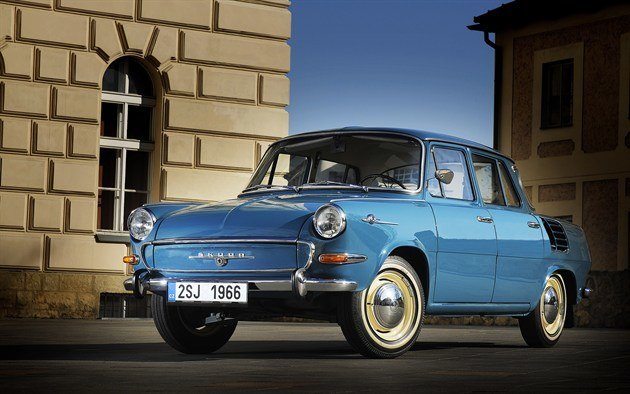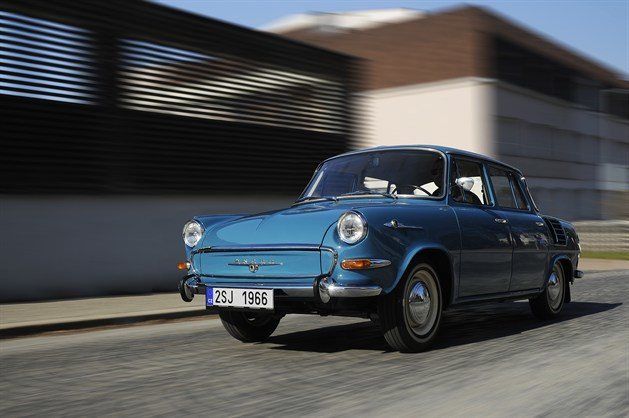March 1964
Skoda 1000MB is launched
The Skoda 1000MB replaced the Octavia, and was the first Škoda with rear wheel drive, a rear engine and unibody construction. A completely new plant, a radically new vehicle design, the most advanced engine in its class at that time – the Škoda 1000MB was a revolution for Škoda in the spring of 1964.
The Škoda 1000MB was a bestseller in Czechoslovakia and abroad – sustainably strengthening Škoda’s position in the European automotive industry and shaping the Czech manufacturer’s model strategy until the late 1980s. Around 443,000 Škoda 1000 MBs were produced between April 1964 and August 1969, of which more than half were exported even as far as New Zealand and Australia.
MB stands for Mladá Boleslav, the location of the company’s headquarters; the number 1000 for the displacement of the one-litre engine. The 1000MB was offered in many versions: in addition to the basic version, from 1966 there were versions with increased performance, and the elegant two-door 1000 MBX – a particularly popular model among collectors today.
To construct the new model, ŠKODA built a completely new plant in Mladá Boleslav in close proximity to the existing factory buildings in the early 60s. The new facilities included the most modern equipment housed in a total of more than 40 production halls and other buildings. 13 kilometres of new roads were built in total, in addition to ten kilometres of railway tracks being re-laid and a new switch yard was built on the 80 acre site. The new plant also had its own smelting plant.
The Škoda 1000MB was one of the most advanced vehicles of its time. Developed under the internal name NOV (nový osobní vůz = New Passenger Vehicle), Škoda engineers opted for a completely new vehicle concept with a rear engine, rear-wheel drive, independent suspension and unibody construction.

At the same time, the Škoda 1000MB set standards in terms of innovative engines and drive technology. In developing the engine, ŠKODA was the first European car manufacturer to utilize aluminium die-casting in engine block production. The four-speed gearbox case was also produced using this construction method. For this, Škoda drew on a method originally developed in 1922 by the Czech engineer Josef Polák; the main advantage of which was the significantly reduced production time.
The water-cooled OHV four-cylinder engine, located behind the rear axle, delivered 37bhp. The engine capacity was 988cc. Modern engine technology in conjunction with the low weight of only 787kg ensured excellent fuel consumption. Maximum speed was 78mph. In 1968, the engine power was increased to 43bhp.
Prior to the start of series production, the manufacturer subjected the Škoda 1000MB to extensive endurance tests. A total of 50 test vehicles covered 1.6 million kilometres in 1962. These included drives at extreme sub-zero temperatures in Russia as well as heat and dust drives on Caucasus mountain roads.
In addition to its modern technology, the Škoda 1000MB signalled significant progress in terms of the brand’s design. The classic three-box design was typical of the 1960s. The sweeping lines and gentle curves, and the circular headlamps elegantly set into the fenders, the originally-shaped taillights, the panoramic rear window and the curved air intakes were among the distinctive identifying features of the new Škoda model. The filler neck was located in the right front fender, cleverly hidden under the hinged Škoda badge.
With its compact dimensions (4.17 m long, 1.62 m wide and 1.39 m high), the Škoda 1000MB offered space and comfort for the whole family. Its high functionality with individually folding seats also won over customers. The 220-litre boot lay under bonnet and the spare wheel was located under the boot. The advantage was that the boot did not have to be opened completely to access the spare wheel.
August 1969
Skoda 1000MB production ends
Very special examples of the ŠKODA 1000 MB and the two-door Škoda 1000 MBX model can be seen today at the new Škoda Museum in Mladá Boleslav, including the unique estate prototype. The vehicles also regularly participate at major antique car shows and classic rallies.
| PRODUCTION OF THE ŠKODA 1000 MB MODEL LINE |
| Version |
Number produced |
Year of manufacture |
| 1000 MB Standard |
350,174 |
1964 – 1969 |
| 1000 MB De Luxe |
52,606 |
1966 – 1969 |
| 1100 MB De Luxe |
22,490 |
1967 – 1969 |
| 1000 MBT Tourist |
13,091 |
1968 – 1969 |
| 1000 MBG De Luxe |
3278 |
1966 – 1968 |
| 1000 MBX De Luxe |
1403 |
1966 – 1968 |
| 1100 MBX De Luxe |
1114 |
1967 – 1969 |
| Total |
443,156 |
|


.jpg?width=640&height=426&rmode=crop)
.jpg?width=640&height=426&rmode=crop)
.jpg?width=640&height=426&rmode=crop)
.jpg?width=640&height=426&rmode=crop)
.jpg?width=640&height=426&rmode=crop)
.jpg?width=640&height=426&rmode=crop)

 Art deco styling, and cool details now
Art deco styling, and cool details now
 Rear engined saloon lacking in space and quality
Rear engined saloon lacking in space and quality

